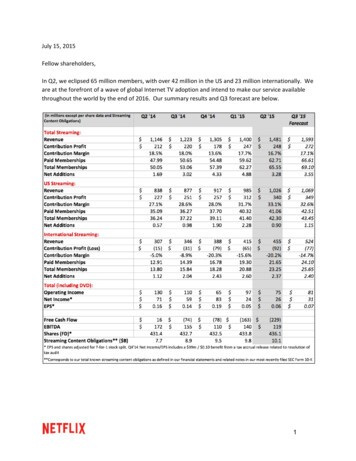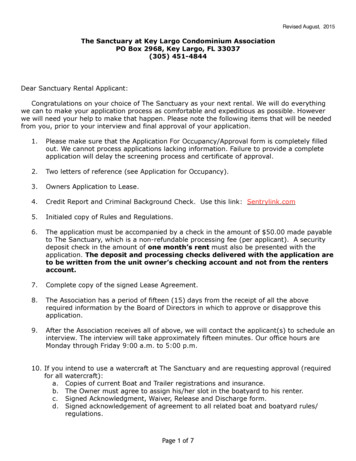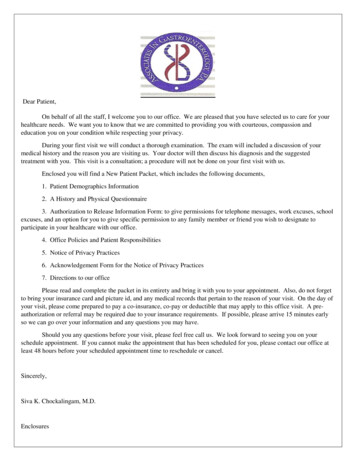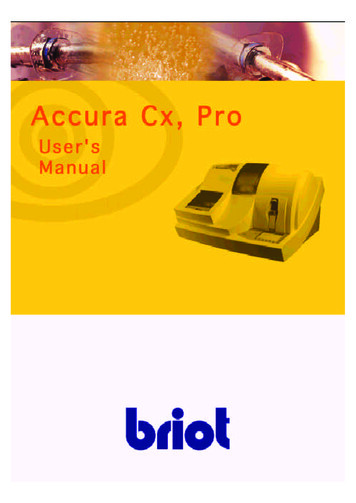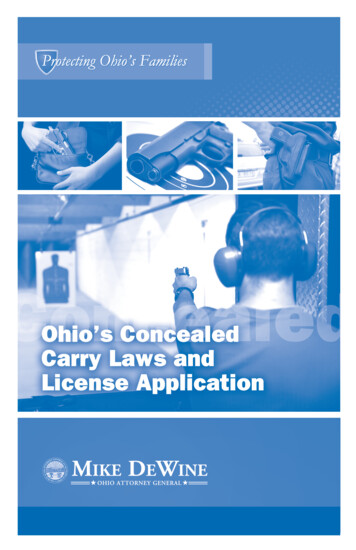
Transcription
Dear Fellow Ohioan,As Ohio’s Attorney General, I am pleased to bring you thisupdated publication summarizing our state’s concealed carrylaws. This edition covers changes made in Ohio House Bill 234that become effective March 23, 2015.Licenses to carry concealed handguns are an important partof the responsible exercise of our fundamental rights.I am committed to the comprehensive training of lawenforcement and the public regarding concealed carrylaws, expansion of reciprocity agreements with other stateswhenever possible, and protection of the public.I hope you find the information in this publication informative,and I welcome your comments and suggestions.Very respectfully yours,Mike DeWineOhio Attorney General
ContentsIntroduction.1Training and Educational Requirements.2Training and Competency CertificationTemporary Emergency LicenseMinimum Educational RequirementsThe Application Process.5Sheriff’s Criteria for Issuing the License.6Ohio Residents in the Armed ForcesCriminal Record & NICSMental CompetencyProtection OrdersLicense Denials and AppealsLicense Renewals and Competency RecertificationDuties that Accompany Holdinga Concealed Handgun License.10Identification RequiredForbidden Carry ZonesTransporting in Motor VehiclesTraffic Stops and Other Law Enforcement EncountersPrivate Property and the Workplace.14SignageConcealed Carry by Law EnforcementReciprocityOpen CarryDeadly Force.15Criminal IssuesCivil LiabilitySelf-DefenseCastle DoctrineDefense of OthersConclusion: Self-Defense IssuesDefense of Property
Dispute Resolution.21Basic Forms of Dispute ResolutionAdvantages of Alternative Dispute ResolutionFinal Summary.22Index.23
IntroductionAs required by Ohio law, this publication broadly discusses severalareas of firearms law. This is neither a formal nor informal opinion ofthe Attorney General; rather, it is a summary of prevailing firearmsand self-defense laws and may be updated without notice. It is notintended to be a substitute for the advice of a lawyer or for commonsense.This publication is informational in nature and cannot cover allpossible scenarios regarding carrying concealed handguns. For themost recent edition covering the most current laws, consult theAttorney General’s website at www.OhioAttorneyGeneral.gov.There are many areas of Ohio law that impact your decision to bea concealed carry licensee, and you should consult an attorney forspecific information. The Ohio Attorney General cannot provide legaladvice to anyone other than state agencies, elected state officialsand employees.In this publication, “CCW” stands for “carrying a concealed weapon”and refers to the Ohio license to carry a concealed handgun pursuantto Ohio Revised Code Section 2923.125. Also, sections of the OhioRevised Code — the laws passed by the General Assembly — arereferenced with the abbreviation “ORC” followed by the relevant codenumber. The Revised Code is available online and also may be foundat law libraries and some public libraries. Citizens are encouraged toread the law themselves and use this book as a guide.Laws change!For the most up-to-date information on carrying a concealedhandgun, visit the Attorney General’s website atwww.OhioAttorneyGeneral.gov.1
Training and Educational RequirementsTraining and Competency CertificationBefore you obtain a license to carry a concealed handgun, you willneed proof of your competency certification. Competency can beestablished by providing one of the following: A certificate of completion of a firearms safety course that wasoffered by or under the auspices of a national gun advocacyorganization. A sheriff issuing a license must determine if anorganization qualifies. The course must meet certain minimumeducational requirements (See the section of this publicationtitled, “Minimum Educational Requirements” for additionalinformation about the specific areas that must be covered intraining.); or A certificate of completion of a class that was open to the publicthat used instructors approved by a national gun advocacyorganization or Ohio Peace Officer Training Commission (OPOTC),or approved instructors of another state and was offered underthe authority of a law enforcement agency of Ohio or anotherstate, college, or firearms training school that meets the minimumeducational requirements; or A certificate of completion of a state, county, municipal, or OhioDepartment of Natural Resources (ODNR) peace officer trainingschool that is approved by the executive director of OPOTC thatcomplies with the law’s training requirements and meets theminimum educational requirements; or A document that shows the applicant is an active or reservemember of the armed forces, has retired from, or was honorablydischarged, or is a retired highway patrol trooper, or is a retiredpeace officer or federal law enforcement officer and who, throughthe position, acquired experience with handguns or other firearmsthat was equivalent to the minimum educational requirements; or A certificate of completion of a class not otherwise described inthis publication that was conducted by an instructor who wascertified by an official or entity of Ohio, another state, the UnitedStates government, or a national gun advocacy organization thatcomplies with the minimum educational requirements; or An affidavit from a qualified instructor that attests to theapplicant’s completion of a course that satisfied the minimumeducational requirements; or A document that shows the applicant has successfully completedthe Ohio Peace Officer Training Program contained in ORC 109.79.Statutory Reference(s): The types of competency certifications are described inORC 2923.125(B)(3)(a)–(g).2
Temporary Emergency LicenseThe law allows for the issuance of an emergency license withoutproof of competency certification under extraordinary circumstances.The law states that upon receipt of evidence of imminent danger;a sworn affidavit; an application fee of 15, plus the cost of eithera BCI or FBI background check; and a set of applicant fingerprints,a license will be issued. To determine the actual cost, consult yourcounty sheriff. This license may be issued to an Ohio resident or nonresident temporarily staying in Ohio.The sheriff must immediately conduct a criminal records check onthe applicant. The sheriff must determine whether the applicant isprohibited from having a license and, if not, immediately issuethe license.1. Evidence of imminent danger must take two forms:a. A sworn statement by the applicant that states he hasreasonable cause to fear a criminal attack upon himself or amember of his family such as would justify a prudent personto arm himself; orb. A written document from a government entity or publicofficial describing facts that give the person reasonable cause tofear such a criminal attack. Such documents may include, but arenot limited to, temporary protection orders, civil protection orders,a protection order of another state, a court order, and any reportfiled with or made by a law enforcement agency or prosecutor.2. The sworn affidavit must attest that the applicant is a legalresident of the United States, at least 21 years of age, not afugitive from justice, is not under indictment or charged with acrime, and has not been convicted of disqualifying crimes listed in ORC2923.125(D)(1) and discussed under the “Application Process” sectionof this publication.If the applicant has been convicted of or pleaded guilty to adisqualifying offense and they have been relieved from this disabilityunder operation of law or legal process, that offense(s) shall not berelevant for purposes of the sworn affidavit. For information on relieffrom disability, consult a private attorney.The temporary emergency license lasts for 90 days and may berenewed only once every four years. If you wish to have your licenselast longer, you must apply for the license through the normalprocess and present proof of competency certification.Statutory References: ORC 2923.1213 allows sheriffs to issue emergency licenses whenthere is evidence of imminent danger to the applicant. ORC 2923.1213(B)(3) does not allowsheriffs to consider sealed records for purposes of the sworn affidavit. To obtain a temporaryemergency license, visit your local sheriff’s office or download the application form atwww.OhioAttorneyGeneral.gov.3
Minimum Educational RequirementsThe Attorney General does not endorse any particular form oftraining or instructor. However, a list of instructors certified by theOhio Peace Officer Training Commission (OPOTC) who wish to teachclasses to the general public is available on the Attorney General’swebsite at www.OhioAttorneyGeneral.gov. County sheriffs alsomay have a list of certified instructors who have provided contactinformation to the sheriff.The law sets out minimum educational requirements that are acomponent of the various forms of competency certification as setforth previously. The total time required for training is 8 hours with aminimum of 2 hours of in-person training that consists of range timeand live-fire training.The law requires certified training in the following matters: The ability to name, explain, and demonstrate the rules forsafe handling of a handgun and proper storage practices forhandguns and ammunition; The ability to demonstrate and explain how to handleammunition in a safe manner; The ability to demonstrate the knowledge, skills, and attitudenecessary to shoot a handgun in a safe manner; Gun-handling training.Additionally, you must have two hours of in-person training, includingrange time and live-fire experience. The applicant also mustcomplete an examination that tests his competency. The test mustinclude a written section on the ability to name and explain the rulesfor the safe handling of a handgun and proper storage practices forhandguns and ammunition. Additionally, the exam must include anin-person physical demonstration of competency on handgun usageand rules for safe handling and storage of a handgun. It also mustrequire a physical demonstration of the attitude necessary to shoota handgun in a safe manner.The training and written exam may be completed online or as acombination of in-person and online training. The online portionof the training must include a component that regularly engagesthe person.As part of the training, applicants also must receive and certify thatthey have reviewed a copy of this publication.4
As an advisory to consumers, the Attorney General recommendsanyone contemplating private handgun training take the followingminimum steps before paying for any form of training: Verify the person teaching the class is qualified to teach. Confirm the instructor knows the requirements of the law. Be certain the instructor will provide you with this publication. Verify whether a refund or additional training may be availableif a county sheriff determines, when you apply for a license, thatthe course did not meet the law’s requirements.Statutory Reference(s): ORC 2923.125(G)(1) requires that all applicants be given the websiteaddress where this publication may be found. This publication may be found atwww.OhioAttorneyGeneral.gov.ORC 2923.125(G)(2) requires that applicants take and pass a written examination.The Application ProcessTo begin the application process, you must apply to the sheriff inthe county where you reside or an adjoining county. Before youapply with your local sheriff, call ahead to determine the timesapplications are accepted and confirm what documentation maybe necessary.The sheriff must accept applications and supporting documents fortemporary emergency licenses during normal business hours. Thesheriff must provide application forms and accept license applicationsand supporting documents for regular licenses at least 15 hours eachweek. The sheriff shall post a notice of the hours during which the sheriffis available to accept applications or to provide information about thelicensing process.The sheriff must provide you with the internet link to obtain a printableapplication form and this pamphlet. You must pay a fee, which willvary depending on the background check the sheriff must conduct.The minimum fee for a background check and license is 67. Youmust provide evidence of your competency certification as describedabove and certify that you have read this publication. Applicants alsomust submit their fingerprints, which are necessary to conduct thebackground check.The applicant must state whether he has a concealed handgunlicense that is currently suspended and whether or not he haspreviously applied for a concealed handgun license. If the applicanthas previously applied for a license, the applicant must provide thename of the county in which the application was made.All licenses expire five years after the issue date.5
Statutory Reference(s): Under ORC 2923.125(A), upon request, the sheriff must provide youwith the application form at no charge and the website address at which this publication maybe found. This publication may be found at www.OhioAttorneyGeneral.gov.ORC 2923.125(B)(4) requires that applicants certify that they have read this publication.ORC 2923.125(B)(1)(a) states applicants must pay an application fee that will vary based onthe type of background check required and sets the minimum fee at 67.ORC 2923.125(B)(2) requires applicants to provide a color photograph taken within30 days of the application date. However, some sheriffs’ offices may take thesephotographs themselves.ORC 2923.125(B)(3) requires that applicants submit proof of competency at the timeof the application.ORC 2923.125(B)(5) requires applicants submit to fingerprinting necessary to conduct abackground check.Sheriff’s Criteria for Issuing the LicenseOhio Residents in the Armed ForcesYou are considered an Ohio resident for purposes of obtainingand renewing a license to carry a concealed handgun if you areabsent from the country, Ohio, or an Ohio county while complyingwith military or naval orders as an active or reserve member ofthe armed forces of the United States. Prior to leaving this statein compliance with those orders, you must be legally living in theUnited States and be a resident of this state. Solely by reason ofthat absence, you are not considered to have lost your status asliving in the United States or your residence in this state or in thecounty in which you were a resident prior to leaving this state incompliance with those orders. This is without regard to whether ornot you intend to return to this state or to your county. Your spouseor dependent is also exempt from the residency requirementsduring the period of your service and for 6 months after if they werelicensed before your active duty begins or obtained a license whileyou are on active duty if they relocated outside of Ohio during yourperiod of service. Your spouse or dependent may also make anapplication to renew your license during the period of your activeduty or service.Statutory Reference: ORC 2923.125(D)(1)(a) allows persons deployed in the military to obtainOhio concealed carry licenses under certain conditions.Criminal Record & NICSPrior to obtaining your license, you must provide the sheriff withcomplete information about your background. There are manycriminal offenses that bar you from obtaining a license. There aremany laws and conditions that prohibit you from owning a handgun.If you have questions about specifics, you should consultan attorney.6
You must also pass a federal NICS (National Instant CriminalBackground Check System) check to obtain an Ohio ConcealedCarry License. The NICS system is maintained and administered bythe FBI. The NICS check will be completed by the sheriff when youapply. The required NICS check is not done by a licensed gun dealer.If you cannot purchase a gun from a federally licensed gun dealer,you will not be able to obtain an Ohio Concealed Carry License.Questions regarding NICS, NICS checks and appealing NICS-baseddenials should be directed to the Federal Bureau of Investigation’swebsite: http://www.fbi.gov/about-us/cjis/nics.To obtain an Ohio Concealed Carry License, the following must alsobe true: You must not have had a concealed carry license issued byanother state suspended. If you live in another state, you must be employed in Ohio. You cannot be an unlawful user of, or addicted to any controlledsubstance as defined in 21 U.S.C. 802. If you are a nonimmigrant alien legally in the United Statesyou must have a nonimmigrant visa as defined in the federalImmigration and Nationality Act, 8 USC 1101(a)(26). You must not have been discharged from the Armed Forces ofthe United States under dishonorable conditions. You must not have renounced your United States citizenship. You must not have been convicted of, pleaded guilty to, oradjudicated a delinquent child for committing a violation ofsection 2919.25 of the Revised Code (Domestic violence) or asimilar violation in another state.The law states that you must not be under indictment, be chargedwith, or convicted of any felony. You also must not be underindictment, charged with, or convicted of an offense that involvestrafficking in drugs, a misdemeanor offense of violence, or negligentassault. You may not obtain a license if you have been charged withfalsification of a concealed handgun license.In addition, you must not have been convicted, pleaded guilty,or been adjudicated as delinquent in connection with a crimethat involves the illegal use, sale, possession, administration,distribution, or trafficking of a drug of abuse. You cannot havebeen convicted, pleaded guilty, or been adjudicated as delinquentfor assaulting a peace officer. You must not, within three yearsof your application, have been convicted, pleaded guilty, or beenadjudicated as delinquent in connection with a misdemeanoroffense of violence.7
You must not have been convicted, pleaded guilty, or beenadjudicated as delinquent in connection with two or more assaultsor negligent assaults within five years of your application. Youmust not have been convicted, pleaded guilty, or adjudicated asdelinquent in connection with resisting arrest within 10 years ofyour application. If you are charged with an offense during theapplication process, the sheriff can suspend your application untilyour case is resolved.The sheriff shall not consider the conviction, guilty plea, oradjudication of an applicant’s sealed records even if those sealedoffenses would otherwise disqualify an applicant. If you havequestions about sealed criminal records, consult an attorney.Mental CompetencyThe law states that you must not have been adjudicated as a mentaldefective, committed to any mental institution, under a currentadjudication of incompetence, found by a court to be mentally illsubject to hospitalization by court order, or an involuntary patientother than one who is a patient only for purposes of observation.Protection OrdersYou must not be subject to a civil protection order or a temporaryprotection order of an Ohio court or a similar protection order issuedby another state. For additional information on civil and temporaryprotection orders, consult an attorney.As long as you meet the law’s requirements, the sheriff must issue aconcealed handgun license within 45 days of receiving your properlycompleted application. The license lasts for five years.Statutory Reference(s): The criminal offenses that bar a citizen from receiving a concealedcarry license are listed in ORC 2923.125(D)(1)(a)–(s).ORC 2923.125(D)(3) allows a sheriff to suspend the processing of an applicati
The sheriff must provide you with the internet link to obtain a printable application form and this pamphlet. You must pay a fee, which will vary depending on the background check the sheriff must conduct. The minimum fee for a background check and license is 67. You must provide evidence of your competency certification as described





